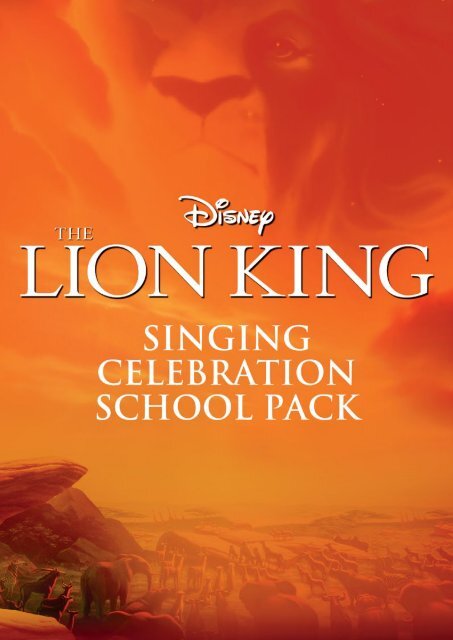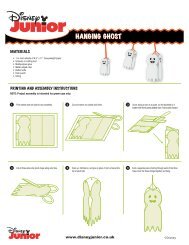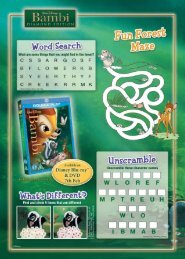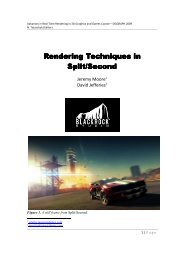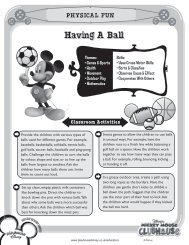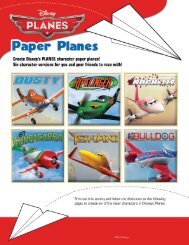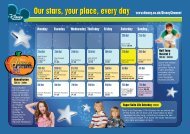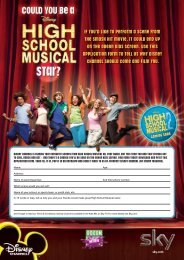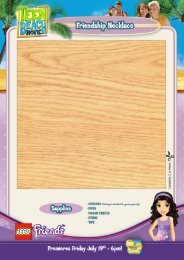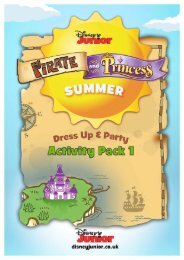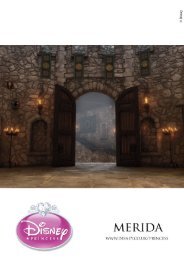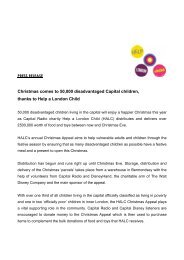Create successful ePaper yourself
Turn your PDF publications into a flip-book with our unique Google optimized e-Paper software.
<strong>Contents</strong>Introduction 1Why The Lion King is an exciting learning resource 2About <strong>Disney</strong>’s The Lion King 2Introducing the story of The Lion King 3The Lion King Singing Celebration 5Simba dance activity (3-5 years old) 6Simba music activity (6-7 years old) 8Pumbaa composition and freeze frames activity (7-9 years old) 10Timon music activity (9-11 years old) 12Preparing for a performance 14Pick and mix activities across the curriculum 15Hakuna Matata lyric sheet and music 18Singing Celebration fun stuff 29Bug buffet 30Activity sheet 31Colouring sheet 32The Lion King Singing Celebration schools’ competition 33How to enter 35Teacher declaration and letter 36Competition rules 40Competition terms and conditions 40Competition checklist 42
Introduction (teachers’ notes)Welcome to the wonderful world of <strong>Disney</strong>’s The Lion King and in particular the songHakuna Matata. In this pack you will find a range of resources to support the primarycurriculum through music, dance and enjoyment.This pack is designed to be flexible and to be used in whatever way is useful for teachingand learning in your school, from stand-alone lessons to whole school assemblies, collapsedcurriculum days or performances for parents.In this pack you will find:• notes on introducing the story and watching the film with your class• detailed lesson plans with music at the centre, leading to a full school performanceof the song Hakuna Matata• extension activities across the curriculum• song words and sheet music• fun resources, such as colouring sheets, which can be included in lessons or taken hometo carry on the fun of learning• Details on how to enter the Lion King Singing Celebration Schools’ Competition includingcompetition rules, waiver and declaration formsHakuna Matata is the song on which the lesson plans are based and we are offering a greatopportunity for your school to video your class performance and upload it to <strong>Disney</strong>’s websiteat www.disney.co.uk/lionkingschools to enter a competition.The winning class will get a unique performance from members of The Lion King Musical castfor their entire school at their school’s assembly!For further details on how to video your class and how to enter the competition please seedetails at the end of the pack or online at www.disney.co.uk/lionkingschools1
Why The Lion King IS an exciting learning resourceThe story of The Lion King was developed as a new idea for the 1994 film, but The Lion King isdrawn from several classical sources: The Epic of Sundiata, which tells the story of the origins of theMali Empire, the Bible stories of Joseph and Moses and elements of Shakespeare’s Hamlet. It followsa classic narrative structure including journeying, coming of age, and triumph of good over evil.The music and dance opportunities are highly accessible and rooted in both European andAfrican influenced tradition. The subject matter lends itself to exploration of the animalkingdom, African culture, friendship, confidence and bravery and much, much more.Using this popular film will help build a bridge between children’s experience of enjoying acultural artifact outside school, and their learning in school, thereby raising engagement levelsand achievement.About <strong>Disney</strong>’s The Lion KingIn October 2011, <strong>Disney</strong> released a new 3D version in cinemas followed by a new DVD and3D Blu-ray in November 2011 for a new generation to enjoy. Many of today’s primary schoolchildren may only now be becoming aware of it, although others may already know it well.The soundtrack won Academy Awards® for best original score and best original song for CanYou Feel The Love Tonight and is the biggest selling soundtrack for an animated movie ever.The lyrics were written by Tim Rice and the music by Elton John, from original compositions byHans Zimmer.The award-winning stage adaptation of The Lion King opened in New York in 1997 and hassince played in 15 different countries, been performed in 8 languages, won over 70 internationaltheatre awards and been seen by over 60 million people. In London’s West End the show isnow in its 12th year and has been seen by nearly 10 million people and remains one of the WestEnd’s most popular productions; on the 13th of September 2011, <strong>Disney</strong> celebrated the 5000thperformance at The London Lyceum.<strong>Disney</strong>’s The Lion King is the highest-grossing hand-drawn animated film in history.2
Introducing the story of The Lion KingWatching the film or reading the story of The Lion King is the best way to learn the story andmeet the characters.You could divide your viewing or reading into shorter sessions. You can use the sceneselections on the DVD or pause regularly to check for focus and understanding. If youare going to watch the film in one sitting, with older children, talk through the questionsbeforehand and revisit them at the end.Here are some suggestions for discussion during or after the film, they could also be used asprompts for individual writing:• The Circle of Life is the opening song. What is it about?• What do you notice about the sunrise? What colours are used?• What do you feel when you hear the music?• What party or religious event do you know about, with which your family celebrates thearrival of a new baby?• Did you notice the cave painting which Rafiki the baboon makes? What sort of characteris Rafiki? What do you think his part in the story will be?• Simba sings I Just Can’t Wait to be King. Pause the film after this song and ask: what do wethink of his attitude? Will this thinking make him a good leader? (This could lead into a PSHEdiscussion on rights and responsibilities with year 5 or year 6.)• When Simba puts his paw into Mufasa’s larger paw print, what does it make you think about?• “Being brave doesn’t mean you go looking for trouble” – talk about what being brave means.• Scar’s song: how does he impress the hyenas?3
• The death of Mufasa. How does Simba feel? If you could give Simba a bit of advice at thismoment, what would you say to him? How does it make you feel?• “What’s a motto?” Does anyone know? Does the school have a motto? Watch the nextsection, Hakuna Matata, extra carefully because this is the song that you will be learning.• Later, when the three friends are looking at the stars, notice what Pumbaa says aboutthem. Is he right? Do you think Timon has judged him unfairly?• Is Simba right to try to leave the past behind him?• Do you agree or disagree with Rafiki when he says: “the past – you can either run from itor you can learn from it”?• What do you notice about the colours of the pridelands when Simba returns?• How is the atmosphere created by the use of weather and music?• How does the ending make you feel?Further ideas for follow-up:1. On the interactive whiteboard create a thought cloud of the story and its themes which thechildren add to themselves. This could be done during another activity, for example while theyare colouring in Lion King fun sheets or mask making.2. y5/y6 Making a news report of a moment in the film (e.g. the birth of Simba – written or oral).3. y3/y4 Make a presentation in the form of a mini-documentary (written/oral/powerpoint) ona day in the life of Timon and Pumbaa.4
The Lion King Singing CelebrationWe have created four flexible lesson plans to build up to a whole school performance:• Simba dance activity is aimed at early years/foundation stage & year 1 (4-6 year olds)• Simba music activity is aimed at year 2 (6-7 year olds)• Pumbaa composition and freeze frames activity is aimed at years 3 and 4 (7-9 year olds)• Timon music activity is aimed at years 5 and 6 (9 -11 year olds)We have also included a page on preparing for a performance which applies across all agegroups plus a whole range of extension activities for cross-curricular learning.Don’t forget to video your performance to enter The Lion King Singing Celebrationcompetition. Full details of how to enter are available on page 32 of this pack and informationon how to upload your video is available at www.disney.co.uk/lionkingschoolsPlease make sure you have parental permission to video the children and to upload the filmwhere it may be viewed publically on the internet. A <strong>Disney</strong>-approved waiver form is attachedon page 37 of this pack and must be signed by the parent of each child appearing in the video.5
Simba DANCE ACTIVITY (age 4 - 6 years)Children will learn to perform or create a dance/movement piece to accompany the Bridge Walk section of the songHakuna Matata.Lesson objectives•••To find the pulse in the song Hakuna MatataTo perform a marching dance to accompany the song Hakuna MatataPractise, rehearse and present a performance based around the song Hakuna MatataPreparationClaves or similar to keep the beat. Songwords projected or printed, Lion King pictures, DVD clip. This lesson is suitablefor use on an interactive whiteboard.Lesson introduction••Introduce the song Hakuna Matata – have it playing as the children come in. Ask them to sit and clap along on kneesto the song in order to get a sense of the pulse.After the song has finished, pose some questions. Who has heard the song before? Who knows what film the song isfrom? What type of animals are they? What sounds do they make? How do they move or sit? Can you make a face likeTimon or Pumbaa? What do the words mean? What language is it? Where do they speak that? Where is that on theglobe? (See Pick and Mix section for more on this.)• Ask children to practise saying the phrase Hakuna Matata to their neighbour.Activity••Play the Bridge Walk section of the song with the children marching along in time – this will help them to find the pulse.Children to practise a vocal ostinato (a repeating rhythmic pattern) by whispering the phrase “Hakuna Matata” in timeto a steady pulse. Children need to be aware of where the pulse falls within the phrase:Ha-KU-na Ma-TA-ta Ha-KU-na Ma-TA-ta1 2 1 2• The children should be encouraged to tap the pulse on their knees, while whispering the phraseover the top.6
Simba DANCE ACTIVITY (age 4 - 6 years)Activity continued•••PlenaryKeeping a steady beat by clapping or using claves, then ask the children to march around the room keeping to the beat(still whispering).Ask them to repeat the activity, this time chanting the phrase “Hakuna Matata” as they go.Once they are able to do this with some confidence, ask for movement ideas and suggestions, which could be addedto the marching and the chanting, to reflect Simba growing up as he goes on his journey with Timon and Pumbaa.Some ideas could be:i) All the children marching in a line or semi circle; one child representing Simba could begin by crawling in front atone end and then get higher and higher as he reaches the other end.ii) The whole class could start by kneeling/sitting on the floor and tapping the pulse on their knees; as Simba growsup the children could kneel up, then crouch, then stoop, then stand tall, clapping above their heads to symboliseSimba getting physically bigger.iii) One child representing Simba following two others, representing Timon and Pumbaa, who encourage him to followthem and then being joined by more and more children as he “grows”. The lead child could change the movementand the others copy, constantly swapping the leads.iv) Three children representing Simba, Timon and Pumbaa at one end of a line of children representing “trees” or“obstacles”. Simba, Timon and Pumbaa could weave in and out as the children chant the rhythm of Hakuna Matata.Timon and Pumbaa guide Simba through his journey with them.v) Allow time to try out different ideas and allow the children time to develop their suggestions.vi) Practise keeping in time with the bridge section from the DVD clip.vii) The children should include DYNAMICS in the performance. The ostinato should begin as a whisper and grow into achant (mirroring what happens in the clip). The children must be careful not to speed up and to keep the TEMPO steady.Try to record the “final” class performance with a video recorder and allow the children to evaluate their performance.If working towards the assembly performance, children can suggest ways to improve the piece before they perform withthe rest of the school.Curriculum linksPE: 1a, 1b, 2a, 3c, 6a - d7
Simba Music Activity (age 6 -7 years)Children will learn to create sound patterns with different textures to accompany the Bridge Walk section of the songHakuna Matata.Lesson objectives••••To find the pulse in the song Hakuna Matata.To perform a vocal ostinato chanting pattern to accompany the song Hakuna Matata.To use untuned junk instruments (see Preparing for Performance).Practise, rehearse and present a performance based around the song Hakuna Matata.Preparation•••Collect /make various untuned percussion instruments (see Preparing for a Performance).Songwords (printed or projected), Lion King pictures, DVD clip.This lesson is suitable for use on an interactive whiteboard.Lesson introduction• Introduce the song Hakuna Matata – have it playing as the class comes in. Ask the children to sit and clap along tothe song in order to get a sense of the pulse.• After the song has finished, pose some questions. Who has heard the song before? Who knows what film thesong is from? What do the words mean? What language is it? Where do they speak that? Where is it on a map/globe?(see Pick and Mix resources.)Activity• Children to practise a vocal ostinato (a repeating rhythmic pattern) by whispering the phrase “Hakuna Matata” in time toa steady pulse. Children need to be aware of where the pulse falls within the phraseHa-KU-na Ma-TA-ta Ha-KU-na Ma-TA-ta1 2 1 2• The children should be encouraged to tap the pulse on their knees whilst whispering the phraseover the top.8
Simba Music Activity (age 6 -7 years)Activity continued• Divide the class and ask half the class to whisper the ostinato while the other half keep the pulse, then swap. Reinforcethe importance of listening while they’re performing!• Practise keeping in time with the bridge section from the DVD clip.• Ask 8-10 children who are confident at keeping the beat, to pick up an instrument. Ask them to tap the shakers againsttheir hand or use water bottle drums to keep the pulse. This will add another sound layer to and change the TEXTUREof the piece. Practise to get the children in time with the clip.• The children should include DYNAMICS in the performance. The ostinato should begin as a whisper and grow into achant (mirroring what happens in the clip). The children must be careful not to speed up and to keep the TEMPO steady.• When the pattern is established, swap the instruments so that everyone has a turn.PlenaryTry to record the “final” class performance with an audio or video recorder and allow the children to evaluate theirperformance. Children can suggest ways to improve the piece before they perform for the rest of the school. This group canoperate as an orchestra to the younger group who have been working on the SIMBA 1 lesson plan.Curriculum linksMusic: 1a, 1b, 1c, 2a, 3b, 4b, 4c, 5c9
Pumbaa COMPOSITION AND FREEZE FRAMES ACTIVITY (age 7 - 9 years)Based on the song Hakuna Matata. Children will learn to:• Create different sounds on percussion instruments to accompany the song.• Create ‘freeze frames’ to represent key moments from the song.The activities can be rotated in a carousel to take place within one lesson or can be split into separate sessions.Lesson objectives••To compose rhythmic sound-scapes.To create visual ‘freeze frames’.PreparationCollect /make various untuned percussion instruments*, Lion King masks**, songwords (printed or projected), Lion Kingpictures, DVD clip. This lesson is suitable for use on an interactive whiteboard.*See Preparing for a Performance. **See Pick and Mix resources.Lesson introduction• Introduce the song Hakuna Matata – have it playing as the children arrive. Ask the children to sit and clap along to thesong in order to get a sense of the pulse.• After the song has finished, pose some questions. Who has heard the song before? Who knows what film the song isfrom? What do the words mean? What language is it? Where do they speak that? (See Pick and Mix resources.)Activity•• Using the song words, ask all children to sing along to the clip to get a sense of the shape of the song.Outline the tasks.i) Half the class will be creating some rhythms and sounds to accompany the song.ii) Half the class will create freeze frames for key moments in the song.• Divide the class and create a composition and a freeze frame group.• Allow time for practising and refining their ideas.10
Pumbaa COMPOSITION AND FREEZE FRAMES ACTIVITY (age 7 - 9 years)Activity continuedComposition• Children should create a simple accompaniment for the chorus.• The children need to be aware of where the pulse falls within the song and should practise keeping in time witheach other and the song clip.• The children should work together to select and choose different kinds of untuned percussion instruments(e.g. scrapers/shakers/woodblocks/junk percussion) and create sounds that work well together and fit with the music.FREEZE FRAMESPlenary• Children should choose 3 or 4 key moments from the song to represent with tableaux or freeze frames. Here aresome suggestions:i) Timon and Pumbaa welcome Simba to the savannahii) Pumbaa singing about how sad he used to feeliii) Encouraging Simba to try the bugsiv) The saying of the phrase Hakuna Matatav) The three friends happy togetherTry to record the “final” class performances focusing on the work of both groups with a video recorder and allow the childrento evaluate their performance. If working towards the assembly performance, children can suggest ways to improve the piecebefore they perform for the rest of the school. Still photographs of the final freeze frames could be projected as a slideshowback drop to the final performance.Extension – for the final, whole school performance you will need to cast three actors from this group toperform the spoken section of Hakuna Matata. See Preparing for Performance for tips for actors.Curriculum linksMusic: 1a, 1b, 2a, 2b, 3b, 4b, 5a, 5cDrama: 4a - d11
Timon MUSIC activity (age 9 - 11 years)• Children will learn to sing the songs Hakuna Matata and Circle of Life.• Look at the messages conveyed in the two songs.• Compare and contrast the songs focusing on the performance styles.•Sing the songs confidently with a view to performing them in a whole school assembly.This session could be divided into two lessons.Lesson objectives•••To understand the messages in the two songs.To compare the song styles.Perform the songs with confidence.PreparationSong words (could be projected), sheet music, DVD clips of the songs. This lesson is suitable for use on an interactive whiteboard.Lesson introduction•• Introduce the songs Hakuna Matata and Circle of Life.After the songs have finished, pose some questions. Who has heard the songs before? Who knows what film the songs arefrom? What do the words in Hakuna Matata mean? What are the main messages within the songs? Are there any similarities inthe songs or do they have a contrasting message? (The class may notice that they both have repeated vocal ostinato sections.)Activity•Begin by warming up the voices – see the www.singup.org for more details on the warm-ups listed below:i) Rhythmic chants: sing chants to warm up at the beginning of a lesson e.g. Bananas of the World Unite.ii) Also use short rhythmic words, e.g. zip zop na na. Teacher or child says the words and the class echo. Practise, focusingon both pulse and rhythm.iii) Vocal warm-ups: 1, 121, 12321 and Senwa dedende.12
Timon MUSIC activity (age 9 -11 years)Activity continued• Begin with Hakuna Matata. Using song sheet provided, ask all children to follow the words as the clip plays, to get asense of the shape of the song. They will be singing the main body of the song, up to the spoken section. Divide the classinto Timon, Pumbaa and Simba groups, following the colour coding of the song sheet. Then using “my turn, your turn”technique, teach the song a section at a time.• Once the children are familiar with the song, look at the key singing skills. Focus on:i) Posture – encourage good posture by asking children to stand tall, knees loose and feet apart. Everyone shouldbreathe together through their mouths. Encourage low breathing (that is, without breathing into the chest andwithout raising the shoulders) by asking the children to take a drink of air that goes right down low, “as if your tummyis a tank of air”. To stop the shoulders rising, children should imagine carrying heavy objects in each hand.ii) The singing face – encourage the children to lift the face by smiling. To help them project the sound, use afollow-my-leader activity. Humming phrases of songs will also encourage an unforced, well blended sound.iii) Breathing – thinking of the diaphragm during the long notes, encourage the children to place a hand just abovetheir tummy button, to use the diaphragm to let the air go slowly.iv) Rehearsal – focusing on the performance of the songs and the context of the scenes in the two songs.v) Performance – thinking about the songs in the context of the rest of the story.PlenaryOnce confident with the two songs, revisit Hakuna Matata and divide into parts for the final chorus. Remind the children to focus ontheir own part while being aware of the others.Try to record the “final” class performances focusing on the work of the whole class singing both songs: Circle of Life in unisonfollowed by Hakuna Matata in parts. Try to capture both songs with a video or sound recorder and allow the children to evaluatetheir performance. If working towards the assembly performance, children can suggest ways to improve the piece before theyperform for the rest of the school.Curriculum linksMusic: 1a, 1c, 3c, 4a, 4b, 4d, 5a, 5c, 5e13
Preparing for a performancePlanningAs a whole class, create a timeline of all the jobs which will need to be done before the performance is ready; encourage thechildren to suggest what needs to be included: e.g. learning the song and rehearsing, mask making, backdrop painting, posterdesign for the show, checking that the video camera is ready and creating invitations for parents.Making junk instrumentsSimple shakers can be made by half-filling plastic food containers with rice or dry lentils – snap the lid on and tape round it,in case curious fingers open it!Empty water containers from water coolers make excellent drums – experiment with using the flat of a palm, soft-headed beatersor hard drum sticks to make different sounds. Play on the base of the container, with it lying horizontally across the knee.Elastic bands over yoghurt pots can be effective to create a pizzicato effect, but you will need quite a few, playing in unison tocompete with the louder sounds.RehearsingMake sure rehearsals are broken down into manageable chunks of time appropriate to the year group and keep feedbackpositive.Explore ways of including the dance and freeze frame elements form the lesson plans. Decide how many times you will runthrough the song, extend the ostinato section or repeat the chorus to enable each group a chance to show their work.Encourage children to offer feedback – use the two stars and one wish pattern (two things we thought were very good andone thing we could improve on).Tips for actorsThe ability to change from singing to speaking voice while staying in character is a classic technique from musical theatre.Watch closely how Timon does it. Warm up speaking voices with tongue twisters. Remind actors that they will need to takedeep breaths to reach the back of the hall with their voices, as the audience will be accustomed to the volume of the singersand percussion musicians.PerformingBe aware that some children are genuinely very nervous of performing. Explain that professional actors and singers getnervous too, it is a very natural reaction and gives performers the buzz they need to give a great show! You can even link thisto Science and explain that it’s part of the adrenalin reaction, flight or fight. We don’t need to run away, there is no real danger,so, like Simba, we can meet the challenge and give the show our best fighting energy!Singing togetherYou will find that all the children, whatever age, will be keen to sing the song, so make sure that your performanceends with a reprise of the chorus of ‘Hakuna Matata, what a wonderful phrase’, in which they can all join in.14
Pick and Mix Activities Across the CurriculumLyric writingHakuna Matata – no worries! is Timon and Pumbaa’s song which sums up how they feel about life. Can the class come upwith a new verse, which could be their own theme song? Brainstorm the positive qualities they think their class has (brave,hard-working, welcoming, kind, fun, friendly). The trick is to find a phrase that fits the same rhythm as Hakuna Matata.Make sure you are aware of where the pulse falls within that phrase.e.g.Year Five is Amazing, Hard-working, Trail-blazing!Pupils will have to think hard about syllables and rhythms. If you are preparing for a school Hakuna Matata assembly,this will give each class the chance to sing their theme song as an extended chorus.Art and designCreate a backdrop to the performance – using either:••• •• a collage/mural of African art and flags which could be created in different classes and then put together by y5 or y6.a landscape of the African savannah. Research the shapes and colours of grasses and trees that might be found there.using diluted poster paints, create a colour wash reflecting the colours of the film. Explore how the colours change fromthe warm, happy savannah to the monochrome world of the pridelands after Scar’s hyenas have decimated the herds.backdrops can be painted onto sheeting, or use inexpensive lining paper.if you are lucky enough to have stage lights in your school, explore how using different coloured gels can change themood of the scene.Mask making• Simple masks can be made by copying the image of Simba’s face to scale (or Timon or Pumbaa), asking children to colour itin and then sticking the face onto a paper plate, making eye holes and attaching elastic.• Hand draw/paint masks onto paper plates, adding tissue paper or a collage of fabric to create texture, fur, manes etc.••Create masks from scratch, made to measure for each child straight onto their faces. Use gummed strips, soaked in water– MAKE SURE CHILDREN APPLY A THIN LAYER OF VASELINE TO THE SKIN FIRST AND PLEASE CHECK FOR ALLERGIES.In pairs, over-layer the strips onto the child’s face, leaving a nose, mouth and eye holes. When complete and just beginningto dry, lift very carefully off and place on newspaper to dry overnight. The next day masks can be painted.Costume and set design• Explore the block printing techniques of African textile design.• Dress up in bright colours, use coloured chiffon scarves to make the grass and rivers.15
Pick and Mix Activities Across the Curriculum continuedDance and movementExplore traditional African dances and design a welcome dance that fits in with the Hakuna Matata pattern.The movement of animalsWatch the opening sequence and The Circle of Life. Assign each child an animal to watch. Explain that the animators ofthe film watched real animal movement to get the drawings right. Explore how each animal stands, walks, travels across thespace. Choreograph a dance to The Circle of Life, which evokes the sense of the animals migrating.The pouncing lessonRevisit the film (at approximately 09.48 minutes). The whole class could play a version of grandmother’s footsteps, wherethey are all lion cubs practising pouncing. If Zazu, the hornbill, catches them moving he will send them back to the beginning.They need to move like lion cubs, so they should think about how domestic cats move when they are getting ready to pounce.One version of this game includes a ribbon tucked into the belt of the ‘grandmother’ – in this case, it could represent Zazu’s tailfeather, which is stolen by the successful Simba, who then becomes the new Zazu.History and citizenship• AFRICAN History – Research the history of the Mali Empire, founded by Sundiata, who was at first denied his rightfulplace as heir.• Sons as heirs – What has recently been in the news about the British royal family?GeographyAsk if the children know where The Lion King is set. Use a large world map or project onto the whiteboard. Can they show youwhere Africa is? Do they know which language the words Hakuna Matata come from? (Kiswahili, as it is officially called, butalso known as Swahili). Does anyone know in which countries in Africa it is spoken? Did you notice other points in the filmwhen Swahili is spoken?Swahili is the official language of Tanzania, Kenya, Uganda and the Democratic Republic of Congo but it is also spoken bycommunities in the following countries: Burundi, Comoros, Malawi, Mauritius, Mozambique, Oman, Rwanda, Seychelles,Somalia, Southern Sudan.Can you find the flags of these countries? These could be painted and added to a backdrop for the performance or addedto a display.Mark, or point to, on the map any countries which people in the class have visited or where they have family.If you are using a paper map link up all the points with ribbon or coloured thread to show we are all part ofone world family.16
Pick and Mix Activities Across the Curriculum continuedDid you know?••• Nala means gift•••Several character names are based on words in SwahiliSimba means Lion or courageous warriorMufasa means kingPumbaa means lazy or careless – is that a fair description of him?When Rafiki sings:“Asante sana squashed banana, Wewe nugu mimi hapana” – Simba asks him what it means.“Asante sana” means “thank you very much” – the rest means “you’re a baboon and I’m not” – just as Rafiki says.It is a nonsense rhyme sung by children.Why not practise saying “asante sana” and then research all the different ways of saying “thank you” that childrenand staff in school might know.Science – animalsResearch task: using the school library or the internet, find out about African lions. Try:•• www.bbc.co.uk/nature/life/Lionanimals.nationalgeographic.com/animals/mammals/african-lion/Here are a few research questions to get started:• Trace or print a map of Africa – colour in where African lions live• What do they eat?• What is their habitat like?• How far do they roam?• Can you find three facts about their family life?PSHE (Personal, Social and Health Education)Dealing with BereavementFor some children in your class, bereavement will be a reality, whether it is the loss of a parent or grandparent, anotherfamily member or even a pet. If you watch the whole film, Simba’s story may trigger sad feelings. This is a normal andhealthy response and will give the child an opportunity to share. Thank the child for telling you about what hashappened and remind everyone that it is very important to share our feelings.17
Essential ResourcesHakuna MatataLyric sheet and music18
SimbaTimonPumbaaHakuna Matata!What a wonderful phraseHakuna Matata!Ain’t no passing crazeIt means no worries for the rest of your daysIt’s our problem-free philosophyHakuna Matata!Hakuna Matata?Yeah. It’s our motto!What’s a motto?Nothing. What’s a-motto with you?Those two words will solve all your problemsThat’s right. Take Pumbaa hereWhy, when he was a young warthog...When I was a young wart hogVery niceThanksHe found his aroma lacked a certain appealHe could clear the savannah after every mealI’m a sensitive soul though I seemthick-skinnedAnd it hurt that my friends neverstood downwindAnd oh, the shameHe was ashamedThought of changin’ my nameOh! What’s in a name?And I got downheartedHow did ya feel?Everytime that I...Hey! Pumbaa! Not in front of the kids!Oh. SorryHakuna Matata! What a wonderful phraseHakuna Matata! Ain’t no passing crazeIt means no worries for the rest of your daysIt’s our problem-free philosophyHakuna Matata!Hakuna Matata! Hakuna Matata!Hakuna Matata! Hakuna Matata!Hakuna Matata! Hakuna Matata!Hakuna Matata! Hakuna!It means no worries for the rest of your daysIt’s our problem-free philosophyHakuna Matata! (repeats)I say “Hakuna”I say “Matata”Ha-kuuu-na MatataHakuna Matata(repeat while fading loud to soft)Music by Elton John, lyrics by Tim RiceJoin in the fun atwww.disney.co.uk/lionking19
THE LION KINGSINGING CELEBRATIONMORE FUN STUFF29
© 2011 <strong>Disney</strong> 30
The Lion KingSinging CelebrationSchools’ competition33
The Lion King Singing Celebration Schools competitionTo celebrate the creation of The Lion King Singing Celebration School Pack, <strong>Disney</strong> is givingschools the chance to enter a unique competition. Designed to get your school singing, allyou have to do is video your class, year, music group, choir or group of your choice, singingHakuna Matata from <strong>Disney</strong>’s The Lion King.Once you have made your video and uploaded it via the website atwww.disney.co.uk/lionkingschools your video will be entered into a competition to win aunique performance from members of The Lion King Musical at your school’s assembly.Hakuna Matata is a great song to sing and The Lion King Singing Celebration SchoolPack is full of great ways for you and your students to learn the music and pull together aperformance to remember.Read on to find out more about how to enter and also make sure to visitwww.disney.co.uk/lionkingschools to upload your video and be in with a chance to win amagical and memorable prize for your school to enjoy.34
Teacher Name: ________________________________School Name: ________________________________Class Name: ___________________________________School ID Number: ______________________________THE LION KING SINGING CELEBRATION – SCHOOLS’ COMPETITIONTEACHER DECLARATIONI _________________________________________(teacher name) at__________________________________________________(school name).do hereby DECLARE AND UNDERTAKE as follows:1. I am a head/music teacher at the above mentioned school.2. I have prior authorisation from the head teacher at the above mentioned school for my class to take partin The Lion King Singing Celebration Schools’ Competition.3. That I have informed the parent or legal guardian of each child appearing in the competition entry videoand have their consent for their child to appear in the video, which will be posted onwww.disney.co.uk/lionkingschools and therefore will be publically available on the internet. A copy ofthe letter which was sent to each parent is attached at Appendix A.4. No child whose legal guardian or parent has not consented to their child taking part in the competitionappears in the competition video.5. A list of the children whose legal guardian or parent has consented to appear in the video is attached inAppendix B.6. That I have read and agree to the full terms and conditions of the competition as set out on the <strong>Disney</strong>website and in The Lion King Singing Celebration Schools’ Pack.ACKNOWLEDGED AND AGREED BYSIGNED _________________________DATE ___________________________(Please sign and return this to The Walt <strong>Disney</strong> Company Limited, The Lion King Singing Celebration –Schools’ Competition, 3 Queen Caroline Street, Hammersmith, London W6 9PE. Your class video will only beeligible to be entered into the competition and published on the website once <strong>Disney</strong> is in receipt of this signeddeclaration)Page 1 of 5 36
Teacher Name: ________________________________School Name: ________________________________Class Name: ___________________________________School ID Number: ______________________________Appendix AExample letter to send to parents for consentNOTICE: THE LION KING SINGING CELEBRATION – SCHOOLS’ COMPETITIONThe Lion King Singing Celebration School Pack is a set of themed lesson plans created by The Walt<strong>Disney</strong> Company, for use in UK primary schools. As music is a mandatory part of the primary schoolcurriculum The Walt <strong>Disney</strong> Company aims to support schools to inspire and build on the realenthusiasm for music through these The Lion King themed lesson plans.By taking part in The Lion King Singing Celebration each music class will have the opportunity to enterinto a competition, for a chance to win a unique performance from The Lion King Musical cast for theirentire school.In order to enter the competition we will be videoing your child’s class performing Hakuna Matata.The competition entry will be uploaded to <strong>Disney</strong>’s The Lion King websitewww.disney.co.uk/lionkingschools where it will be judged by a panel of judges based on ‘bestperformance’ of the song. The performance will take place at the winning school during morningassembly.If you do not wish your child to take part in the competition element of The Lion King SingingCelebration please either contact the school or complete the attached slip below. If you have anyquestions please contact me directly.Kind regards.[teacher name][teacher contact details]-----------------------------------------------------------------------------------------------------------------------------Return slipLegal Guardian/Parent name: ________________________________________________Child Name: _____________________________________________________________□ I do not consent to my child taking part in The Lion King Singing Celebration CompetitionPage 2 of 5 37
Teacher Name: ________________________________School Name: ________________________________Class Name: ___________________________________School ID Number: ______________________________Appendix BList of children appearing in video and confirmation that consent obtainedPRINT CHILD’S NAMEPARENT/GUARDIANCONSENT OBTAINED(please tick)Page 3 of 5 38
Teacher Name: ________________________________School Name: ________________________________Class Name: ___________________________________School ID Number: ______________________________PRINT CHILD’S NAMEPARENT/GUARDIANCONSENT OBTAINED(please tick)Page 4 of 5 39
<strong>Disney</strong> Competition RulesOne winning class will win a performance from members of The Lion King Musical cast for their entireschool at their school’s assembly.‘You’ means the authorised teacher responsible for entering the competition in accordance with these rules.How to enter:You can enter online at www.disney.co.uk/lionkingschools.You must register your school details with <strong>Disney</strong> and create a schools’account to enter. Further instructions are set out on the website.Video your class singing along to Hakuna Matata from The Lion King,upload the video to the site and your class could win a unique performancefrom members of The Lion King Musical for your entire school.Get some handy tips by reading our Video Tips Guide!General video upload rulesStart date: December 12 th , 2011• Video must be of your school class only. You must have prior consentfrom a legal guardian/parent of each child featured in the video.• Videos should be no longer than 10 minutes.• Please do not wear clothes with visible logos or brand names (display ofschool badges is fine).The winning class will be selected by a panel of judges who will select theentry demonstrating the ‘best performance’ of the song, your class isencouraged to have fun and sing with gusto!Closing date for entries:Entry restrictions:Prize details:April 15 th , 2012 at 16h00Only valid for schools registered in the United Kingdom.Valid entry must be submitted by either a head teacher, music or classteacher. The teacher must obtain the permission from each parent whosechild appears in the video. The teacher must submit and return a declaration(provided in The Lion King Singing Celebration Schools’ Pack) to <strong>Disney</strong> atthe address below.One winning class will win a performance from The Lion King Musical castfor their entire school at their school’s assembly.The performance date must take place by June 30, 2012.<strong>Disney</strong> will work with the winning school to select a mutually suitable datefor the performance.General terms & conditionsThe teacher of the winning class will be notified by <strong>Disney</strong> by May 5 th , 2012.The Promoter is The Walt <strong>Disney</strong> Company Limited, 3 Queen Caroline Street, London W6 9PE(“<strong>Disney</strong>”). If you have any questions please contact Customer Services at help@disney.co.uk or writeto The Lion King Singing Celebration – Schools’ Competition, The Walt <strong>Disney</strong> Company, 3 QueenCaroline Street, London W6 9PE.By participating you agree to the requirements set out in all promotional materials and the followinggeneral terms and conditions.1. Eligibility.a. You must register your school details and have an active schools’ account to enter.b. Maximum one entry per class. Schools may enter more than one class.c. Only online entries via the competition website will be accepted. Entries must becompleted online by the closing date.40
2. Personal Information. To enter we will ask you to register your school details with us. Yourdetails and information will be used to administer the competition. We will ask you to providea list of the names of the pupils appearing in the video together with confirmation that eachlegal guardian/parent has permitted their child to participate. Once the competition has endedall personal information will be destroyed.3. Winner Selection.a) <strong>Disney</strong> will moderate all entries and reserves the right not to accept entries which aretechnically unacceptable, contain inappropriate material or breach any of these terms andconditions. <strong>Disney</strong> reserves the right to choose a short-list of entries and publish thesefinalists on the competition website. Publication of any entry does not mean that yourclass has won.b) Competition entries and/or shortlisted entries will be reviewed by a panel of judges and awinner will be selected according to the judging criteria set out on the competition entrypage. The judges shall have the sole and absolute discretion to decide on the award of eachprize.4. <strong>Disney</strong>’s Liability.a. For online entries: <strong>Disney</strong> cannot guarantee continuous, uninterrupted or secure access tothe website and is not responsible for any disruption to the competition or the website dueto technical problems or otherwise due to events outside of its reasonable control.5. <strong>Disney</strong> has arranged this competition in good faith but, to the fullest extent allowed by law,accepts no responsibility for loss or damages as a result of anyone participating in thecompetition or any aspect of any prize awarded.6. Prize Confirmation & Acceptance. If your class wins and either you are not contactable oryour school declines to accept the prize, <strong>Disney</strong> reserves the right to withdraw prize entitlementand award the prize to a substitute winner chosen at the same time as the first winning classwas selected or judged to be a winner.7. Prize Fulfilment. No cash or other alternative prizes are available, except that in the event ofcircumstances outside of its control <strong>Disney</strong> reserves the right to substitute a similar prize ofequal or greater value. Unless otherwise stated in the prize description. <strong>Disney</strong> reserves theright to ask the winning class (or the legal guardians/parents of the children featuring in theentry video) to sign a written release before awarding any prize. <strong>Disney</strong> reserves the right torequest proof of identity or to verify eligibility conditions and to award any prize to the winningschool in person.8. Cancellation or Disqualification.a. <strong>Disney</strong> reserves the right to disqualify late, misdirected, incomplete, corrupted, lost,illegible or invalid entries.b. <strong>Disney</strong> reserves the right to modify, suspend, cancel or terminate the competition orextend or resume the entry period or disqualify any participant at any time without givingadvance notice and will do so if it cannot be guaranteed that the competition can becarried out fairly or correctly for technical, legal or other reasons or if <strong>Disney</strong> suspects thatany person has been manipulating entries or the results, or has provided false informationor has acted unethically in any other way.9. Email safety. In the event that <strong>Disney</strong> wishes to contact you in connection with your classes’entry we will do so via an email ending in 'disney.com' or by phone with a follow up e-mail.Any email which appears to come from <strong>Disney</strong> but using a different ending (e.g. hotmail.com,yahoo.com etc) should be treated with suspicion and forwarded to Customer Services. DO NOTrespond or act on any e-mail if you are not sure that it comes from <strong>Disney</strong>. If you are in anydoubt please contact Customer Services.10. Publicity. The winning video will be published on www.disney.co.uk . Winning class may berequired to participate in reasonable related publicity without further payment or permission.You agree that <strong>Disney</strong> may publish school name, class name, town/city.11. Winners' details. For information regarding the name of the winning school (and, ifapplicable, their winning entry) go to the <strong>Disney</strong> Winners' Gallery or send a stamped andaddressed envelope to the Customer Services address on the competition entry page quoting“Winners List”: The Lion King Singing Celebration – Schools, Competition.12. No purchase necessary.13. <strong>Disney</strong>'s decision to select any winner is final and we reserve the right not to correspond on anymatter.14. The laws of England apply and any disputes will be dealt with in the English courts only.© <strong>Disney</strong>41
The Lion King Singing CelebrationCompetition Entry Check ListHave you collected waiver forms for each child that appears in your Hakuna Matata performance?Have you completed The Lion King Singing Celebration Teacher Declaration form (including both Appendix A and B)to accompany your entry?Have you posted your completed declaration form and appendices to The Walt <strong>Disney</strong> Company Limited, The Lion KingSinging Celebration Schools Competition, 3 Queen Caroline Street, Hammersmith, London, W6 9PEHave you visited the website www.disney.co.uk/lionkingschools and checked you are able to upload your video?Have you made a video of your class giving their performance of Hakuna Matata?Have you uploaded your video at www.disney.co.uk/lionkingschools?(remember it can take a few days for your video to appear in the gallery so do keep checking back).Watch your video as a class and also check out how other schools have performed.Share your performance with parents and colleagues and encourage them to “like” the performance atwww.disney.co.uk/lionkingschools.Keep singing! The Lion King Singing Celebration is all about your school celebrating this majestic story throughthe music, so keep the celebration going and keep singing.42
The Lion King Singing Celebration Song Pack was written by Helen Cadbury and Molly Newton,with thanks to the staff and children of Heworth CofE Primary School, York.© <strong>Disney</strong>


